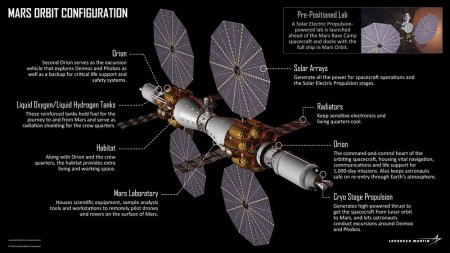May 22, 2016 – It seems like Mars is in the news almost every day. Today Mars is in opposition to Earth. Opposition is a state of optimal position from our perspective here on Earth. This occurs when the Red Planet is directly opposite the Sun. While in this position Mars also makes its closest approach to us and appears brighter and larger. Opposition lasts a few short weeks. Here in the Eastern Time Zone in North America tonight Mars will rise at sunset, achieve perigee at 1:17 in the morning and set at sunrise. View the planet through a telescope because even this close Mars remains a small object.
In the last couple of weeks SpaceX has announced a proposed Red Dragon mission to land a spacecraft on Mars by 2018. Meanwhile Curiosity data has given us a picture of weather conditions for the last two Martian years from the perspective of Gale Crater. Now joining the Mars hype is Lockheed Martin who this week unveiled plans for a Martian laboratory staffed by six to be put in orbit around the planet in 2028. States Tony Antonelli, Lockheed Martin’s chief technologist for civil space exploration, “we think that orbiting Mars is a necessary precursor to landing humans on the surface.”
The plan would be to build a deep space platform with a central-core habitat, multiple Orion spacecraft, liquid oxygen and hydrogen tanks, and solar arrays. Called the Mars Base Camp it would be designed for a 1,000-day mission. All the pieces to build the Mars Base Camp already exist. In fact, Lockheed Martin has proposed a cis-lunar orbital habitat using similar modular elements. In charge of that project is Bill Pratt who sees it as a suitable test platform for the future Mars Base Camp. Pratt states about the cis-lunar proposal, “the habitat would be located just far enough away that astronauts couldn’t easily turn around and come home when problems arise. That really forces us to operate in a different mindset that’s more akin to a long trip to Mars.” Whether a cis-lunar habitat or one destined for Mars, the pieces would be launched from Earth using NASA’s Space Launch System (SLS) currently under development. Assembly would occur in orbit near the Moon. The propulsion technologies would include solar electric (currently being perfected by NASA) and traditional chemical rockets.
The cis-lunar habitat would be designed to accommodate a crew of six for up to 60 days. Between human expeditions it would operate autonomously. The Mars Base Camp, however, would be capable of supporting a crew of six for up to 11 months. In the case of the latter the Base Camp would serve as a launching point for further exploration of the Martian environment. One of the Orion capsules could be used to explore near-Martian space visiting its two moons. On board the Base Camp crew members would remotely operate landers and rovers on the planet’s surface in real time unlike the way we work with Curiosity and Opportunity today with no 20 minute communication time lag between Earth operators and Martian deployed robots. Mars Base Camps could be a launch platform for new technologies including airborne robots to expand our exploration range.
Antonelli, a former shuttle astronaut, says he would like to be one of those assigned to the Mars Base Camp mission, stating, “we think that putting scientists with laboratories right there in Mars orbit will allow them, in just a few months, to accomplish more science than we’ve been able to accomplish in the past 40 years.”
No price tag is put on Lockheed Martin’s plans. Would it be as much as the International Space Station (ISS) which cost to build about $100 billion U.S? More than likely. Would it be a multi-nation effort? Lockheed Martin says nothing about this on their web site but following in the footsteps of ISS, I would think the costs would be shared among the Earth’s space faring nations.
















